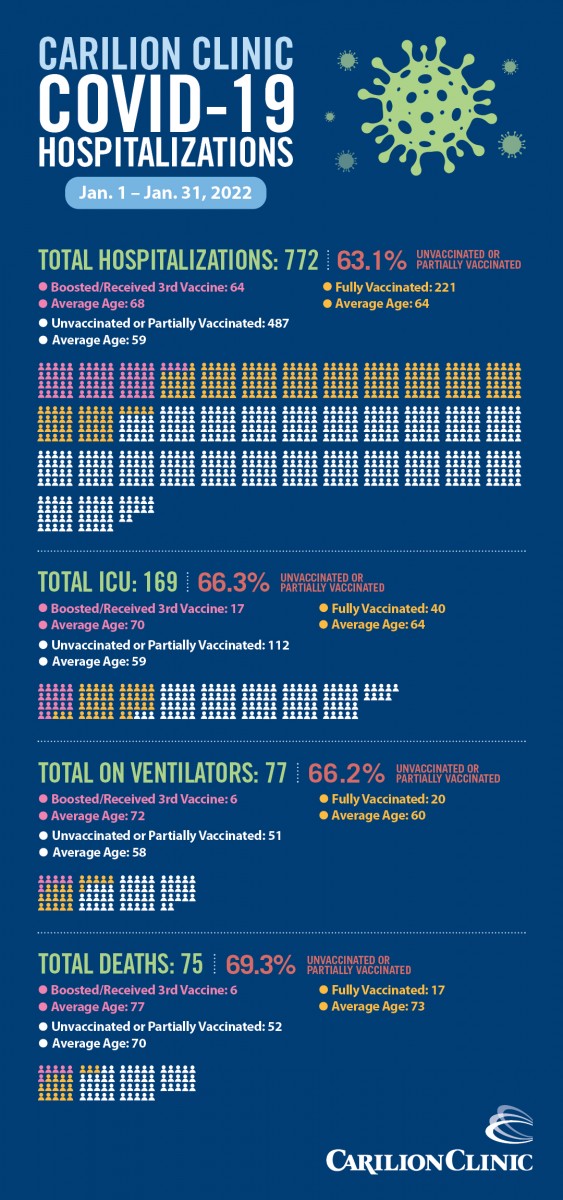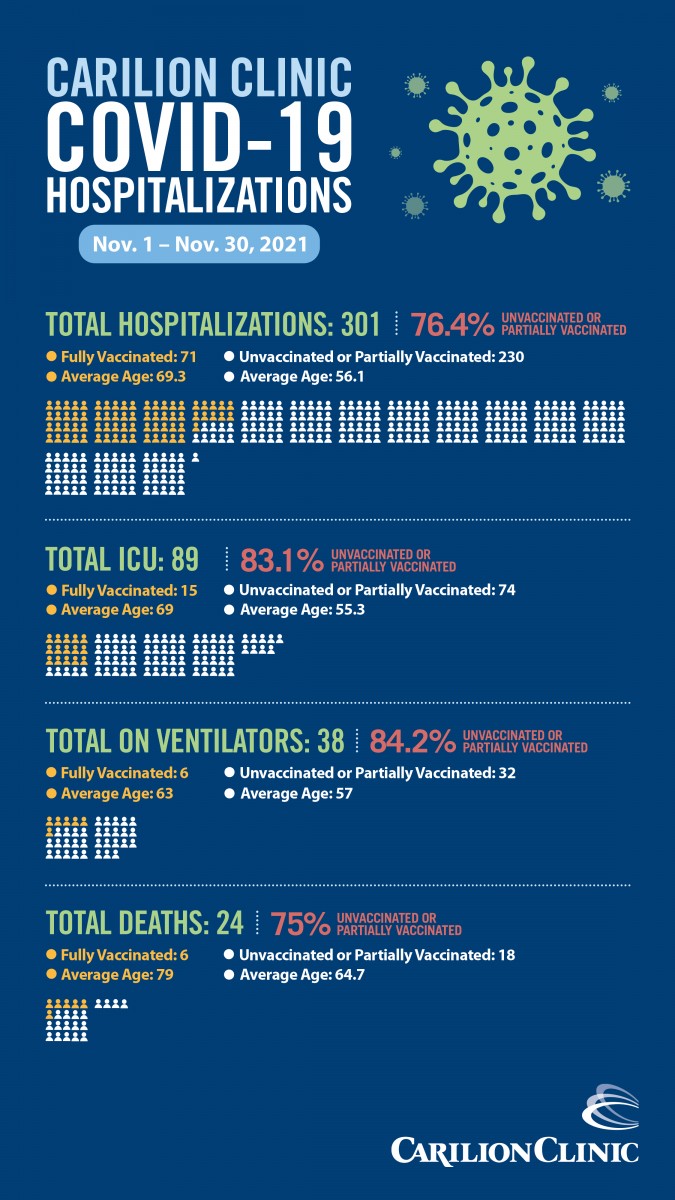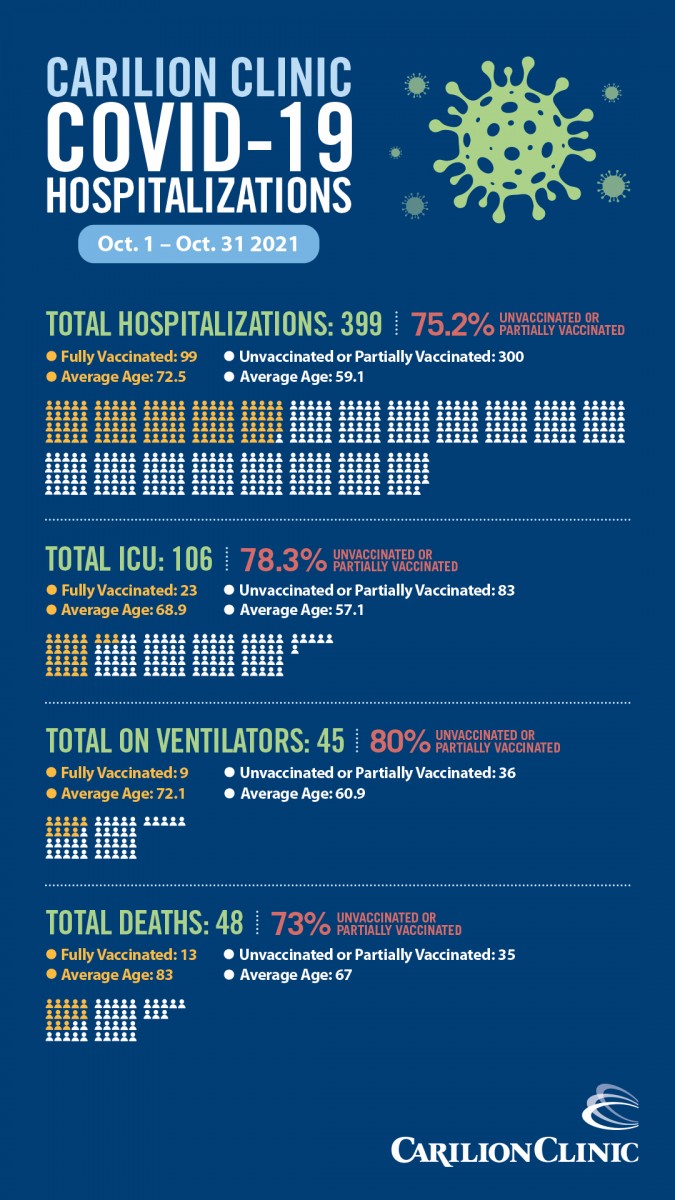Infographic: Carilion COVID-19 Hospitalizations
78% of hospitalized patients in March did not have their third dose/booster dose.
This infographic provides an updated breakdown of COVID-19 hospitalizations across our system during March 2022. Data reflect a moment in time and change regularly.
Here's what the infographic tells our providers:
- Current hospitalizations, serious illness, ventilator use, and deaths are driven by patients who have not received COVID‑19 vaccination.
- We see continued reduced risk for severe disease requiring hospital admission, ICU placement, ventilation need and death in patients who were vaccinated and boosted.
- 78% of hospitalized patients in March did not have their third dose/booster dose. Please get a booster vaccine; it provides the best protection against severe illness and hospitalization. To find a COVID-19 vaccine or booster appointment near you, visit: http://bit.ly/3gX23lr.
- If you are vaccinated and live in an area that is considered high risk by the CDC, it is important to continue to use mitigation strategies, such as masking, distancing, and avoidance of high-risk activities.
Please get a booster vaccine; it provides the best protection against severe illness and hospitalization. To find a COVID-19 vaccine or booster appointment near you, visit: http://bit.ly/3gX23lr.
Please note: individuals are considered fully vaccinated two weeks after the second dose in a two-dose vaccine series (Pfizer and Moderna mRNA vaccines) or two weeks after a single dose vaccine (Janssen/Johnson&Johnson).
______________________________________________________________________________________________
Feb. 2022
The below infographic data range includes monthly totals from March 1 to March 31. These reflect a moment in time and change regularly.
_______________________________________________________________________________________________________________
Jan. 2022
The below infographic data range includes monthly totals from Jan. 1 to Jan. 31. These reflect a moment in time and change regularly.
_______________________________________________________________________________________________________________
Dec. 2021
The below infographic data range includes monthly totals from Dec. 1 to Dec. 31. These reflect a moment in time and change regularly.
_______________________________________________________________________________________________________________
Nov. 2021
The below infographic data range includes monthly totals from Nov. 1 to Nov. 30. These reflect a moment in time and change regularly.
The below infographic data range includes monthly totals from Oct. 1 to Oct. 31. These reflect a moment in time and change regularly.
Frequently Asked Questions: COVID Hospitalizations Infographic
The monthly infographic of Carilion’s COVID-19-related hospitalizations has received a lot of interest and questions. Here are some of the most Frequently Asked Questions about the infographic with answers from Carilion COVID‑19 clinician experts.
What’s the point of Carilion’s monthly infographic?
- This information is released to the public to help inform everyone of the need to take COVID-19 seriously – get vaccinated, mask up, practice social distancing – and show how it is affecting our health system and our community. We also want to highlight the effectiveness of the COVID-19 vaccines and encourage everyone to get vaccinated.
Why does Carilion release the infographic on a monthly basis? Why not more frequently?
- This information is constantly changing, so to get a better perspective of our COVID-19 patients over time, it is most effective to look at one month of data rather than a snapshot from week to week or day to day.
Why doesn’t the infographic include community vaccination rates?
- The Virginia Department of Health reports the community vaccination rates and COVID‑19 cases. This information is accessible at https://www.vdh.virginia.gov/coronavirus/covid-19-in-virginia/
Common Definitions:
- Hospitalization: Anyone (adult or child) admitted into the hospital. Does not include those seen only in the Emergency Department (ED) who are then discharged from the ED.
- Fully Vaccinated: Individuals are considered fully vaccinated two weeks after the second dose in a two-dose vaccine series (Pfizer and Moderna mRNA vaccines) or two weeks after a single dose vaccine (Janssen/Johnson&Johnson).
- Partially Vaccinated: Individuals who have not completed all their shots or who were infected prior to the two-week time period after the last shot in a series.
Setting the Record Straight about Getting Vaccinated
What story does the infographic tell a physician or scientist?
- These data help clinicians provide information and advice to patients so that they may make the best collaborative decisions about their personal health care and the health of the communities in which they live or visit.
- Here’s what the infographic tells our providers: Current hospitalizations, serious illness, ventilator use, and deaths are driven by patients who have not received COVID‑19 vaccination.
- The data show a small number of vaccinated persons go on to have severe illness, so it is still important that people continue to use mitigation strategies, such as masking, distancing, and avoidance of high-risk activities, since fully vaccinated persons are still at some risk of hospitalization and complications.
- For the patients who were fully vaccinated, the average time from being fully vaccinated to COVID-19 diagnosis was 168 days or about five and a half months, which helps to make the case that individuals should seek booster shots about 6 months after they received the primary series.
Would it be informative to list those with a history of COVID‑19 prior to vaccination in the infographic?
- Studies have shown that vaccination after naturally acquired COVID‑19 enhances protection against serious illness should reinfection with SARS‑CoV‑2 variants occur. Commercially available antibody tests do not correlate with protection against infection or severe illness—only tests for special kinds of antibodies, known as neutralizing antibodies, correlate with protection and these tests are only done in research laboratories and are not commercially available. We therefore have chosen not to include this information in the infographic. The most effective way to prevent illness is to be fully vaccinated, which numerous medical studies have supported.
Why don’t you list partially vaccinated and unvaccinated separately in the infographic?
- Persons who have received less than the full vaccine series or received the final dose in a series less than 2 weeks prior, are not optimally protected. The decreased protection with partial vaccination is substantial. The important message that this infographic emphasizes is that fully vaccinated individuals are best protected against severe illness.
Why are some fully vaccinated persons who are admitted to the hospital with “breakthrough” infection on ventilators?
- The COVID‑19 vaccine, like other vaccines, is not 100 percent effective. Breakthrough infections are possible; however, these infections are less likely to lead to severe illness that requires hospitalization when compared to unvaccinated persons who become infected and develop COVID‑19.
- While severe illness is very unlikely in vaccinated persons, it is possible, especially for older or immunocompromised persons. The few vaccinated patients on ventilators typically have other risk factors for severe disease. Source: https://www.cdc.gov/coronavirus/2019-ncov/vaccines/effectiveness/why-measure-effectiveness/breakthrough-cases.html
Do people who have had COVID-19 need to be vaccinated? How long do antibodies against SARS‑CoV‑2 persist?
- Yes. Even people who have experienced COVID-19 illness and recovered still need to be vaccinated to receive the best immunity to protect them from getting the virus again.
- The antibody tests currently available do not correlate with immunity, so obtaining a laboratory (blood) test that shows antibodies are present does not mean that you are protected against infection or severe illness.
- Research tests that measure neutralizing antibodies, which do correlate with protection but are currently not available to the public, show that vaccination confers the most protective immunity, even for those who have had prior infection or symptomatic illness.
- There are also protective immune responses that do not rely on antibodies. The relative protection of these types of immunity, and how long they last, are under study.
- Everyone should get vaccinated against COVID‑19, even if you have experienced prior natural infection.
- More information at the CDC’s FAQs here: https://www.cdc.gov/coronavirus/2019-ncov/vaccines/faq.html
How long after you have COVID‑19 can you get the COVID‑19 vaccine?
- People who have had COVID‑19 should wait until they have recovered from their illness and are out of self-isolation before getting vaccinated for COVID‑19.
- If you have symptoms, the criteria for ending self-isolation include:
- 10 days have passed since your symptoms appeared, and
- 24 fever-free hours have passed without the use of fever-reducing medications, and
- Your other COVID‑19 symptoms are improving
- If you are not experiencing symptoms, there is one main criteria for ending isolation:
- 10 days have passed since your first positive SARS‑CoV‑2 test
- Source: https://www.cdc.gov/coronavirus/2019-ncov/your-health/quarantine-isolation.html
Are the COVID-19 vaccines safe?
- Yes. More than 390 million doses of the COVID-19 vaccines have been given in the U.S. as of September 2021 and they were evaluated in tens of thousands of participants in clinical trials.
- The vaccines met the FDA’s rigorous scientific standards for safety and effectiveness needed to support an Emergency Use Authorization (EUA) and full approval for large groups of persons.
- Common side effects of the vaccine are mild pain at the injection site, headache, tiredness, fever, muscle pain, chills and nausea. Many people experience no side effects at all.
- There are systems in place to monitor the safety of these vaccines and serious safety problems are rare.
- Long-term side effects are very unlikely following any vaccination, including a COVID-19 vaccination. Millions of people have safely received COVID-19 vaccines over the last year.
- Source: https://www.cdc.gov/coronavirus/2019-ncov/vaccines/safety/safety-of-vaccines.html
Has Carilion admitted anyone to the hospital as a result of taking a COVID-19 vaccine?
- No.
- Get vaccinated.
- Take COVID-19 seriously and know what treatment is available to keep you out of the hospital, like monoclonal antibodies.
- Wear a mask and practice social distancing.








